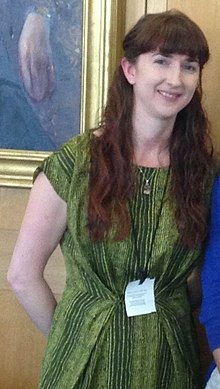
Phobos is the innermost and larger of the two natural satellites of Mars, the other being Deimos. The two moons were discovered in 1877 by American astronomer Asaph Hall. Phobos is named after the Greek god of fear and panic, who is the son of Ares (Mars) and twin brother of Deimos.
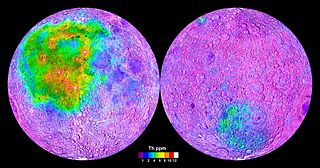
KREEP, an acronym built from the letters K, REE and P, is a geochemical component of some lunar impact breccia and basaltic rocks. Its most significant feature is somewhat enhanced concentration of a majority of so-called "incompatible" elements and the heat-producing elements, namely radioactive uranium, thorium, and potassium.
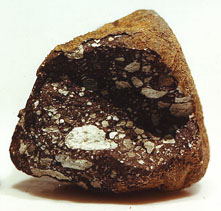
A lunar meteorite is a meteorite that is known to have originated on the Moon. A meteorite hitting the Moon is normally classified as a transient lunar phenomenon.

Mistastin crater is a meteorite crater in Labrador, Canada which contains the roughly circular Mistastin Lake. The lake is approximately 16 km (9.9 mi) in diameter, while the estimated diameter of the original crater is 28 km (17 mi). The age of the crater is calculated to be 36.6 ± 2 million years (Eocene).

The Genesis Rock is a sample of Moon rock retrieved by Apollo 15 astronauts James Irwin and David Scott in 1971 during the second lunar EVA, at Spur crater on Earth's Moon. With a mass of c. 270 grams, it is currently stored at the Lunar Sample Laboratory Facility in Houston, Texas.
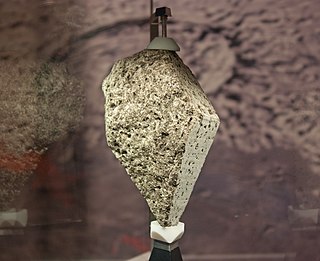
Moon rock or lunar rock is rock originating from Earth's Moon. This includes lunar material collected during the course of human exploration of the Moon, and rock that has been ejected naturally from the Moon's surface and landed on Earth as meteorites.
The Lunar and Planetary Institute (LPI) is a scientific research institute dedicated to study of the solar system, its formation, evolution, and current state. The Institute is part of the Universities Space Research Association (USRA) and is supported by the Science Mission Directorate of the National Aeronautics and Space Administration (NASA). Located at 3600 Bay Area Boulevard in Houston, Texas, the Institute serves as a scientific forum attracting visiting scientists, postdoctoral fellows, students, and resident experts; supports and serves the research community through newsletters, meetings, and other activities; collects and disseminates planetary data while facilitating the community's access to NASA astromaterials samples and facilities; engages and excites the public about space science; and invests in the development of future generations of scientists. The LPI sponsors and organizes several workshops and conferences throughout the year, including the Lunar and Planetary Science Conference (LPSC) held in March in the Houston area.

Troilite is a rare iron sulfide mineral with the simple formula of FeS. It is the iron-rich endmember of the pyrrhotite group. Pyrrhotite has the formula Fe(1-x)S which is iron deficient. As troilite lacks the iron deficiency which gives pyrrhotite its characteristic magnetism, troilite is non-magnetic.

The oldest dated rocks formed on Earth, as an aggregate of minerals that have not been subsequently broken down by erosion or melted, are more than 4 billion years old, formed during the Hadean Eon of Earth's geological history, and mark the start of the Archean Eon, which is defined to start with the formation of the oldest intact rocks on Earth.

The Lunar Magma Ocean (LMO) is the layer of molten rock that is theorized to have been present on the surface of the Moon. The LMO was likely present on the Moon from the time of the Moon's formation to tens or hundreds of millions of years after that time. The LMO was a thermodynamic consequence of the Moon's relatively rapid formation in the aftermath of a giant impact between the proto-Earth and another planetary body. As the Moon accreted from the debris from the giant impact, gravitational potential energy was converted to thermal energy. Due to the rapid accretion of the Moon, thermal energy was trapped since it did not have sufficient time to thermally radiate away energy through the lunar surface. The subsequent thermochemical evolution of the LMO explains the Moon's largely anorthositic crust, europium anomaly, and KREEP material.

Chang'e 5 was the fifth lunar exploration mission in the Chinese Lunar Exploration Program of CNSA, and China's first lunar sample-return mission. Like its predecessors, the spacecraft is named after the Chinese moon goddess, Chang'e. It launched at 20:30 UTC on 23 November 2020, from Wenchang Spacecraft Launch Site on Hainan Island, landed on the Moon on 1 December 2020, collected ~1,731 g (61.1 oz) of lunar samples, and returned to the Earth at 17:59 UTC on 16 December 2020.

Planetary science is the scientific study of planets, celestial bodies and planetary systems and the processes of their formation. It studies objects ranging in size from micrometeoroids to gas giants, with the aim of determining their composition, dynamics, formation, interrelations and history. It is a strongly interdisciplinary field, which originally grew from astronomy and Earth science, and now incorporates many disciplines, including planetary geology, cosmochemistry, atmospheric science, physics, oceanography, hydrology, theoretical planetary science, glaciology, and exoplanetology. Allied disciplines include space physics, when concerned with the effects of the Sun on the bodies of the Solar System, and astrobiology.

Meenakshi Wadhwa is a planetary scientist and educator who studies the formation and evolution of the Solar System through the analysis of planetary materials including meteorites, Moon rocks and other extraterrestrial samples returned by spacecraft missions. She is director of the School of Earth and Space Exploration at Arizona State University.
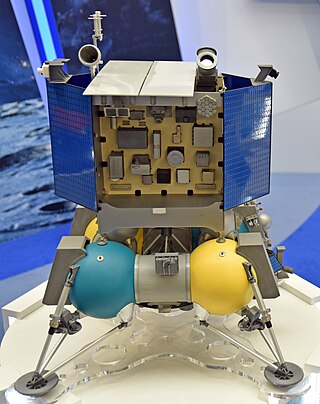
Luna 27 is a planned lunar lander mission by the Roscosmos with collaboration by the European Space Agency (ESA) to send a lander to the South Pole–Aitken basin, an area on the far side of the Moon. Its objective will be to detect and characterise lunar polar volatiles. The mission is a continuation of the Luna-Glob programme.

Barbara Cohen is a planetary scientist at NASA's Goddard Space Flight Center. The asteroid 6816 Barbcohen is named after her.

Lunar Sample 14321, better known as "Big Bertha", is a lunar sample containing an embedded Earth-origin meteorite collected on the 1971 Apollo 14 mission. It was found in the Fra Mauro region of the Moon. Big Bertha is the first discovered meteorite from Earth, and the embedded meteorite portion is the oldest known Earth rock. At 8.998 kg (19.84 lb), this breccia rock is the third largest Moon sample returned during the Apollo program, behind Big Muley and Great Scott.
Ghislaine Crozaz is a cosmochemist known for her research on the early history of the solar system through tracking trace elements in meteorites.

Nicolas Dauphas is a planetary scientist and isotope geochemist. He is a professor of geochemistry and cosmochemistry in the Department of the Geophysical Sciences and Enrico Fermi Institute at the University of Chicago. Within cosmochemistry, his research focus is on isotope geochemistry. He studies the origin and evolution of planets and other objects in the solar system by analyzing the natural distributions of elements and their isotopes using mass spectrometers.
Christine Floss (1961–2018) was a German-born American cosmochemist whose research involved studying the atomic composition of meteorites, interplanetary dust, and moon rocks in order to understand the formation of the Solar System. She was a research professor of physics at Washington University in St. Louis, affiliated with the university's Laboratory for Space Sciences and McDonnell Center for the Space Sciences.
